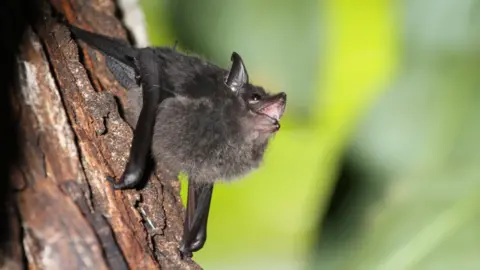Baby bats babble like humans
 Michael Stifter
Michael StifterScientists who systematically eavesdropped on bat roosts in Costa Rica have discovered baby-bat babbling bears a striking resemblance to that of human infants.
The bats produce rhythmic sounds and repeat key "building-block syllables".
And this suggests - just like in human infants - their babbling lays the foundations for communication.
"They just babble away, sunrise to sunset, practising their sounds," lead researcher Dr Ahana Fernandez said.
Dr Fernandez, based at the Museum of Natural History in Berlin, studied a particularly vocal species - the greater sac-winged bat, Saccopteryx bilineata.
"These bats actually sing like songbirds," she said.
"So they have very sophisticated vocal communication - a repertoire of distinct syllable types."
Dr Fernandez and her colleagues, who published their findings in the journal Science, analysed recordings of the bat pups babbling in their roosts.
Characteristic features included:
- the repetition of key syllables adults use in their songs.
- rhythmicity and repetition, very similar to the "da-da-da" sounds of human babies
 Michael Stifter
Michael StifterHuman speech requires very precise control over the vocal apparatus.
Babbling in infants and toddlers is vital practice in gaining that control.
And, the researchers said, the same was true of bats.
"We know all the different syllable types produced by adult bats," Dr Fernandez said.
"And the ones that appear in pup babbling are really reminiscent of the adult ones - so we can clearly tell."
The greater sac-winged bat is the only bat species known to do this so far.
But with more than 1,400 bat species in the world, Dr Fernandez "really thinks there will be another that babbles".
'Really listening'
And while this study has identified a pattern that could be important for many mammals that have to learn to communicate vocally, she also says there is a great deal left to understand about this specific species of singing bat.
"The babies really listen to each other when they're babbling," Dr Fernandez said.
"One starts, he babbles for 15 minutes or so, and I can clearly see the ears of the other pups moving.
"So I think they're really listening to each other - but how it influences their practising, I don't know."
Follow Victoria on Twitter.
